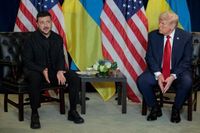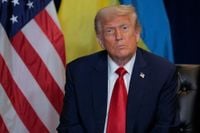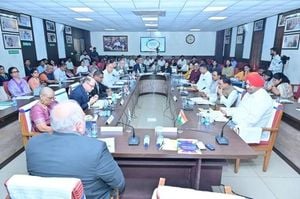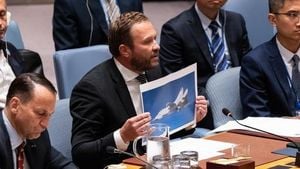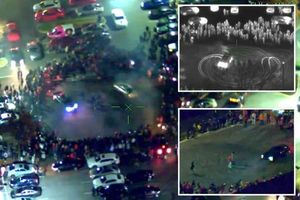In a dramatic turn of events at the United Nations General Assembly in New York on September 23, 2025, President Donald Trump declared that NATO countries should shoot down Russian aircraft if they violate allied airspace, a statement that sent ripples through the international community and reignited debate over the alliance’s response to escalating Russian provocations.
Trump’s remarks came during a closely watched meeting with Ukrainian President Volodymyr Zelenskyy, where the two leaders discussed the ongoing war in Ukraine and the recent string of airspace violations by Russian military jets and drones. The context couldn’t have been more urgent: just days prior, three Russian MiG-31 fighter jets entered Estonian airspace without permission, and at least 19 Russian drones had flown into Polish territory, according to reports cited by ABC News and other outlets. These incidents prompted NATO to scramble fighter jets and left much of Europe on edge.
Pressed by journalists on whether the United States would back up NATO allies in shooting down Russian aircraft, Trump responded, “It depends on the circumstance. But you know, we’re very strong toward NATO.” When asked specifically if countries reporting airspace violations should shoot down the aircraft, Trump replied, “Yes, I do.” He stopped short of pledging automatic U.S. involvement, leaving some ambiguity about the American response in a crisis.
The comments drew swift reaction from European officials. Polish Foreign Minister Radek Sikorski, who has been vocal about the need for a tougher stance on Russia, quickly took to social media to endorse Trump’s position, posting, “Roger that,” on X (formerly Twitter). Meanwhile, NATO Secretary General Mark Rutte sought to strike a balance between deterrence and caution. “Decisions on whether to engage intruding aircraft, such as firing upon them, are, of course, taking in real time, are always based on available intelligence regarding the threat posed by the aircraft, including questions we have to answer like intent, armament and potential risk to Allied forces, civilians or infrastructure,” Rutte said, as reported by ABC News.
The series of airspace violations has put Europe on high alert. Estonia’s report of three Russian jets entering its airspace on September 19 was flatly denied by Moscow, but the episode added to a growing list of incidents, including drone incursions over Poland and the temporary closure of Copenhagen and Oslo airports after drones were detected in the vicinity. Danish Prime Minister Mette Frederiksen told reporters that Russian involvement in these incursions “could not be ruled out.”
Trump’s meeting with Zelenskyy was notable not just for its tough rhetoric, but also for the sense of solidarity expressed between the two leaders. Trump praised Ukraine’s resilience, stating, “We have great respect for the fight Ukraine is putting up,” more than three years after Russia’s full-scale invasion. Zelenskyy, for his part, provided a battlefield update, telling Trump that Ukrainian troops had advanced some 360 kilometers in recent weeks and inflicted significant losses on Russian forces. “Thanks to our soldiers, we have this possibility, this opportunity, and we will continue until Russia will stop this war,” Zelenskyy said, according to coverage by ABC News and international press. He also repeated his call for increased international pressure and more sanctions on Russia, saying, “We need more pressure and more sanctions.”
In his address to the UN General Assembly earlier that day, Trump did not mince words about Russia’s ongoing aggression. “It’s not making Russia look good. It’s making them look bad,” he said. He reiterated his readiness to impose a new round of powerful tariffs on Russia if Moscow fails to agree to a peace deal, insisting that such economic measures could “stop the bloodshed very quickly.” But Trump also emphasized that Europe must step up its efforts, declaring, “Europe has to step it up. They can’t be doing what they’re doing. They’re buying oil and gas from Russia while they’re fighting Russia. It’s embarrassing to them.”
The issue of European reliance on Russian energy has been a persistent thorn in the side of Western unity. European Commission President Ursula von der Leyen, in a bilateral meeting with Trump, voiced her agreement with his call for an end to Russian energy imports. “President Trump is absolutely right on it,” she said. “We have reduced already massively the gas supply from Russia, completely gotten out of Russian coal and massively also reduced the oil supply. But there’s still some coming to the European continent. We want to get rid of it.” Von der Leyen set a target for Europe to abandon Russian energy by 2027 or earlier.
Yet, not all European countries are on board. Hungary and Slovakia have resisted pressure to stop purchasing Russian oil, citing a lack of alternatives. Hungary’s Foreign Minister Péter Szijjártó stated that his country had no intention of stopping purchases, explaining, “They had no infrastructure in place to buy from anywhere else.” Hungarian Prime Minister Viktor Orbán, a close ally of Trump, has also refrained from seeking other energy suppliers. Trump suggested he might be able to persuade Orbán to change course: “He is a friend of mine. I have not spoken to him, but I have a feeling if I did, he might stop. And I think I’ll be doing that.”
Despite months of U.S.-led diplomatic efforts, a comprehensive peace deal between Russia and Ukraine remains elusive. When asked whether he still trusted Russian President Vladimir Putin, Trump replied, “I’ll let you know in about a month from now.” The uncertainty underscores the fragile state of East-West relations and the limits of personal diplomacy in the face of entrenched geopolitical conflict.
After his meeting with Zelenskyy, Trump took to his social media platform to offer an optimistic assessment of Ukraine’s prospects. “After getting to know and fully understand the Ukraine/Russia Military and Economic situation and, after seeing the Economic trouble it is causing Russia, I think Ukraine, with the support of the European Union, is in a position to fight and WIN all of Ukraine back in its original form,” Trump wrote. “Ukraine would be able to take back their Country in its original form and, who knows, maybe even go further than that!”
While Trump’s bold statements have drawn both support and criticism, they have undeniably put renewed attention on the stakes of the war in Ukraine and NATO’s willingness to defend its members. As the situation continues to evolve, European leaders and the broader international community will be watching closely to see whether words translate into action—or if the world is headed for a new and even riskier phase in the standoff with Russia.

